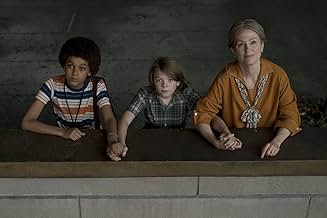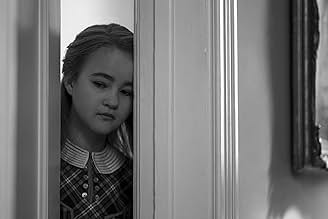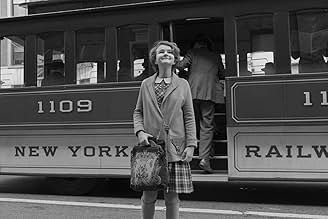IMDb-BEWERTUNG
6,2/10
11.403
IHRE BEWERTUNG
Erzählt die Geschichte von zwei Kindern, die durch fünfzig Jahre getrennt sind. 1927 sucht Rose nach der Schauspielerin, deren Leben sie in ihrem Sammelalbum festhält; 1977 läuft Ben von zu ... Alles lesenErzählt die Geschichte von zwei Kindern, die durch fünfzig Jahre getrennt sind. 1927 sucht Rose nach der Schauspielerin, deren Leben sie in ihrem Sammelalbum festhält; 1977 läuft Ben von zu Hause weg, um seinen Vater zu finden.Erzählt die Geschichte von zwei Kindern, die durch fünfzig Jahre getrennt sind. 1927 sucht Rose nach der Schauspielerin, deren Leben sie in ihrem Sammelalbum festhält; 1977 läuft Ben von zu Hause weg, um seinen Vater zu finden.
- Auszeichnungen
- 1 Gewinn & 35 Nominierungen insgesamt
Zusammenfassung
Reviewers say 'Wonderstruck' is a visually and emotionally rich film exploring childhood, loss, and identity through dual narratives set in 1927 and 1977. The artistic direction, contrasting black and white with color, and the performances, especially Millicent Simmonds, are praised. Music and sound design enhance the atmosphere. However, some find the pacing slow and plot convoluted, making it a divisive yet beautifully crafted film.
Empfohlene Bewertungen
This was almost exactly what I expected based on the average reviews. Definitely a significant downgrade from Carol. I appreciated its ambition and some of its visuals, cinematography, and music is really good. But that screenplay is kind of a huge mess, and such a big missed opportunity. I don't see why this film would get much dislike, but I also don't see why it would get much love either. It's almost the complete opposite of mother!, which is probably the worst spot to be in. As soon as it was over I had forgotten it and felt so much apathy towards it. Not terrible or even bad, but not all that good either.
Director Todd Haynes ("Carol") has brought forth yet another slow paced film with "Wonderstruck". Containing almost no dialogue, the strong score (by Carter Burwell) fills the void of the voices and provides all the sounds of the emotions and environment in which the two main terrific child actors Ben (Oakes Fegley "Pete's Dragon") and Rose (relative newcomer and deaf actress Millicent Simmonds) encounter. At Ben's side, and with a voice, is his new friend and equally talented young actor Jamie (Jaden Michael "Baby Jaguar VO in Dora the Explorer) who unexpectedly helps move the two very different yet parallel stories of Ben and Rose along. While the jumping back and forth from the eras of 1920 (Rose) and 1970's (Ben) kept the film interesting, additional flashbacks explaining Ben's history, a cameo by Michelle Williams as Ben's mom, and double character rolls by Julianne Moore (as Lillian Mayhew and the older Rose) just left me confused and frustrated. Not frustrated enough to walk out, but enough that I just went with the flow and stopped trying to figure things out. Carter Burwell's score will surely be in Oscar consideration, Haynes' ability to capture the various periods will find Oscar traction, and costumes wizard Sandy Powell will once again be in the running for an Award. The film is based on book by Brian Selznick's, and I can hope the storyline in the book was easier to follow.
How is a Todd Haynes film with a character based on Lillian Gish this bad? And why is this his follow-up to Carol?!
This YA mystery – adapted by its author – has an intriguing dual- time structure, a nice Carter Burwell score and some neat nods to silents, but it's also cloying, not very mysterious, and incredibly longwinded: not trusting its audience to understand anything, and struggling with some laborious translation problems reminiscent of Le mèpris, in which a lot of the dialogue has to be written down and held up. It doesn't help that the central kid seems to have wandered in from a school play. Or that it ends up looking like an extended advertorial for some museums.
It's sort of like Hugo, if everything that Scorsese's film had done had gone a bit wrong.
(The Gish films being homaged, incidentally, are primarily The Wind (the poster of the film-within-a-film starring 'Lillian Mayhew' is based directly on a publicity image for this 1928 masterpiece) and Orphans of the Storm, though she played mothers in few of her starring vehicles and Wonderstruck diverts considerably from her real life.)
This YA mystery – adapted by its author – has an intriguing dual- time structure, a nice Carter Burwell score and some neat nods to silents, but it's also cloying, not very mysterious, and incredibly longwinded: not trusting its audience to understand anything, and struggling with some laborious translation problems reminiscent of Le mèpris, in which a lot of the dialogue has to be written down and held up. It doesn't help that the central kid seems to have wandered in from a school play. Or that it ends up looking like an extended advertorial for some museums.
It's sort of like Hugo, if everything that Scorsese's film had done had gone a bit wrong.
(The Gish films being homaged, incidentally, are primarily The Wind (the poster of the film-within-a-film starring 'Lillian Mayhew' is based directly on a publicity image for this 1928 masterpiece) and Orphans of the Storm, though she played mothers in few of her starring vehicles and Wonderstruck diverts considerably from her real life.)
Greetings again from the darkness. If you know an adolescent who is ready to step up from comic book movies, this would be a terrific introduction to more emotionally dramatic and narrative-driven cinema. That's certainly not meant to imply that director Todd Haynes' latest is only for kids, or even that it's aimed at that demographic. Instead, it's the rare opportunity to follow two intersecting story lines over two different time periods with kids as the main focus, and have some very interesting post-movie discussions related to characters, eras, and filmmaking techniques.
We follow the stories of two kids who are separated by 50 years. Although the time boundary exists, the similarities between their journeys are many. Each is running away from home in search of their roots and identity. They are both hearing-impaired and living in less than ideal family environments. Additionally, their footsteps cross many of the same places in New York City as two museums play key roles.
Ben (Oakes Fegley, PETE'S DRAGON) is a 12 year old living in Gunflint, Minnesota. It's 1977 when his mother (Michelle Williams) dies unexpectedly and a freak accident takes his hearing. Convinced an odd bookmark is a clue to finding the father he's never met, Ben sets off for New York City. Rose (remarkable first time actress Millicent Simmonds) lives in 1927 Hoboken, New Jersey and is obsessed with silent screen star Lillian Mayhew (Julianne Moore in a dual role). Rose is an artistic child whose domineering dad has little time for her, so she hops aboard the ferry and heads to the big city to track down an idol - who may be more closely tied than we first imagine.
Brian Selznick adapted the screenplay from his own novel (he also wrote "The Invention of Hugo Cabret", which was the basis for Scorcese's HUGO), and some may find the two story lines muddled or difficult to follow. However, for those who connect with the characters and their adventures, it's a fascinating and entertaining ride. Director Todd Haynes (FAR FROM HEAVEN, CAROL) has established his expertise in visual stylings, and here he gets to present two distinct looks for the separate eras. Ben's 1977 world is filled with the polyester and neon colors of that era and it's even given the washed-out look of 1970's cinema. On the opposite end of the spectrum, Rose's 1927 world is presented in black and white as a silent movie. The lack of dialogue allows us to focus on her facial expressions and body language, which tell us what we need to know.
The American Museum of Natural History plays a significant role in both stories, and the Queens Museum is central to the finale which ties up the two pieces for us. The contrasts of the two eras are as vital as the similarities. Along the way, each of the kids gets a bit of help. Ben befriends Jamie (Jaden Michael) whose connection to the museum and the city provides Ben a boost, while Rose's much older brother Walter (Cory Michael Smith) also has a connection to the museum and helps put Rose on the right track. The distinct photographic styles help us easily switch between eras, and much credit goes to cinematographer (and frequent Haynes collaborator) Edward Lachman and editor Affonso Goncalves.
Oscar Wilde's quote, "We are all in the gutter but some of us are looking at the stars", takes its shot as the theme for the two stories, and really it's a heartfelt film with interesting storytelling and unusual cinematic effects. The set design is terrific throughout, and especially vital during the silent movie segments of Rose's story. Carter Burwell's prominent score also effectively shifts styles between stories and eras. The ties that bind us – a core need to understand our roots – do so regardless of age and time period. This is a nifty little film that provides much to discuss and consider.
We follow the stories of two kids who are separated by 50 years. Although the time boundary exists, the similarities between their journeys are many. Each is running away from home in search of their roots and identity. They are both hearing-impaired and living in less than ideal family environments. Additionally, their footsteps cross many of the same places in New York City as two museums play key roles.
Ben (Oakes Fegley, PETE'S DRAGON) is a 12 year old living in Gunflint, Minnesota. It's 1977 when his mother (Michelle Williams) dies unexpectedly and a freak accident takes his hearing. Convinced an odd bookmark is a clue to finding the father he's never met, Ben sets off for New York City. Rose (remarkable first time actress Millicent Simmonds) lives in 1927 Hoboken, New Jersey and is obsessed with silent screen star Lillian Mayhew (Julianne Moore in a dual role). Rose is an artistic child whose domineering dad has little time for her, so she hops aboard the ferry and heads to the big city to track down an idol - who may be more closely tied than we first imagine.
Brian Selznick adapted the screenplay from his own novel (he also wrote "The Invention of Hugo Cabret", which was the basis for Scorcese's HUGO), and some may find the two story lines muddled or difficult to follow. However, for those who connect with the characters and their adventures, it's a fascinating and entertaining ride. Director Todd Haynes (FAR FROM HEAVEN, CAROL) has established his expertise in visual stylings, and here he gets to present two distinct looks for the separate eras. Ben's 1977 world is filled with the polyester and neon colors of that era and it's even given the washed-out look of 1970's cinema. On the opposite end of the spectrum, Rose's 1927 world is presented in black and white as a silent movie. The lack of dialogue allows us to focus on her facial expressions and body language, which tell us what we need to know.
The American Museum of Natural History plays a significant role in both stories, and the Queens Museum is central to the finale which ties up the two pieces for us. The contrasts of the two eras are as vital as the similarities. Along the way, each of the kids gets a bit of help. Ben befriends Jamie (Jaden Michael) whose connection to the museum and the city provides Ben a boost, while Rose's much older brother Walter (Cory Michael Smith) also has a connection to the museum and helps put Rose on the right track. The distinct photographic styles help us easily switch between eras, and much credit goes to cinematographer (and frequent Haynes collaborator) Edward Lachman and editor Affonso Goncalves.
Oscar Wilde's quote, "We are all in the gutter but some of us are looking at the stars", takes its shot as the theme for the two stories, and really it's a heartfelt film with interesting storytelling and unusual cinematic effects. The set design is terrific throughout, and especially vital during the silent movie segments of Rose's story. Carter Burwell's prominent score also effectively shifts styles between stories and eras. The ties that bind us – a core need to understand our roots – do so regardless of age and time period. This is a nifty little film that provides much to discuss and consider.
Unbelievably dull. Turned it off. Don't bother. Nothing positive to say. Save your time and money.
Wusstest du schon
- WissenswertesIn the book, the story of Rose is told alternatively without text but with graphics to allow the readers to experience Rose's story in the same way she felt escaping to New York City through her eyes and the silence of her life.
- PatzerWhen Ben enters the rotunda of the American Museum of Natural History, he walks past the mounted skeletons of the Allosaurus attacking a Barosaurus defending its young, as seen in the museum today. However, this exhibit was not mounted until 1991, and wouldn't have been seen in 1977.
- VerbindungenFeatured in WatchMojo: Top 10 Failed Oscar Bait Movies of 2017 (2018)
Top-Auswahl
Melde dich zum Bewerten an und greife auf die Watchlist für personalisierte Empfehlungen zu.
- How long is Wonderstruck?Powered by Alexa
Details
- Erscheinungsdatum
- Herkunftsland
- Offizielle Standorte
- Sprachen
- Auch bekannt als
- Kutup Yıldızı
- Drehorte
- Produktionsfirmen
- Weitere beteiligte Unternehmen bei IMDbPro anzeigen
Box Office
- Bruttoertrag in den USA und Kanada
- 1.060.377 $
- Eröffnungswochenende in den USA und in Kanada
- 65.882 $
- 22. Okt. 2017
- Weltweiter Bruttoertrag
- 3.285.916 $
- Laufzeit
- 1 Std. 56 Min.(116 min)
- Farbe
- Sound-Mix
- Seitenverhältnis
- 2.35 : 1
Zu dieser Seite beitragen
Bearbeitung vorschlagen oder fehlenden Inhalt hinzufügen









































